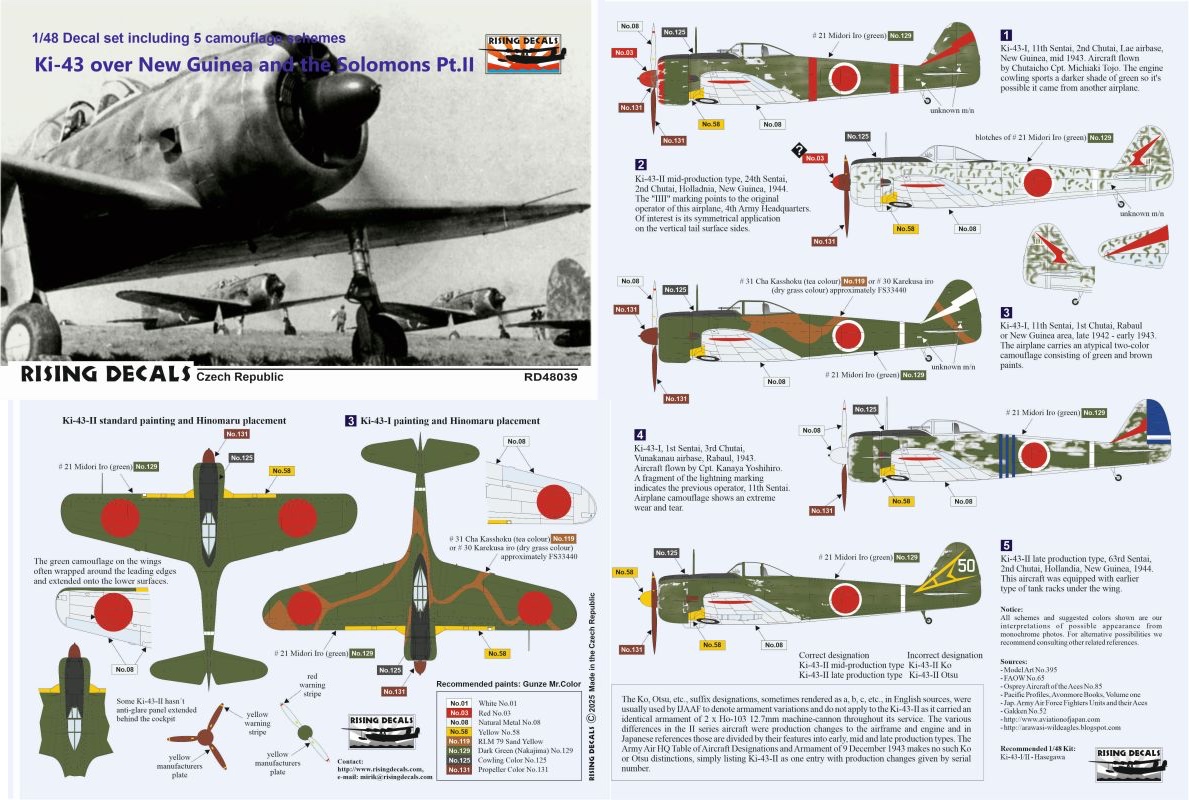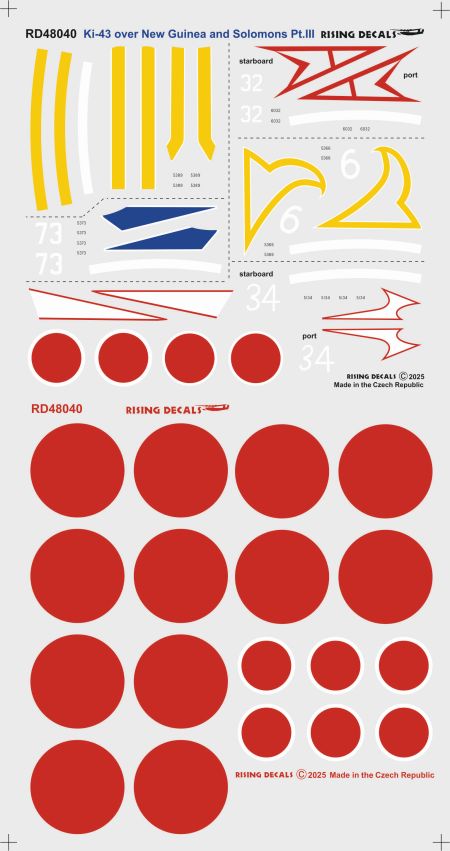A surprise, simultaneous release of three sets of decals in 1/48 scale (does anyone say 'quarter scale' any more?) for the Ki-43 over New Guinea and the Solomons from the prolific saviour of old kits with unusable transfer sheets or new kits with poor ones Rising Decals. All subjects are based on photographs with an acknowledgement that the colours suggested are subject to interpretation - no speculations asserted as facts or 2 + 2 added up to 5. The three sets are reviewed here, beginning with the five subjects in Set RD48038 as follows:-
- # 1 Ki-43-II '5927' of 3rd Chutai 248 Sentai at Alexshafen in 1943; attributed as the aircraft of 3rd Chutai leader Lt Kawamura Takenori from the red fuselage band.
- # 2 Ki-43-II of 3rd Chutai, 59 Sentai at But in October 1943; confirmed as an aircraft flown by 14 victory ace Sgt Maj Tomio Hirohata. The personal bird motif is provided in red or black on the sheet but FWIW the late Dr Yasuho Izawa presented the motif as black in his most recent study of Army aces 'The Imperial Japanese Army Fighter Group 2' (Kaiga Co., 2024). In the original known photograph the bird does appear darker than the Hinomaru and the surprisingly dark looking tail stripe. The decal sheet includes the stripes on the tailplanes, an integral part of the Sentai insignia but omitted in many depictions.
- # 3 Ki-43-II '6984' (not 6983 but printed correctly on the sheet) attributed to 2nd Chutai, 13 Sentai at Kamiri in early 1944, in a scheme of solid light green upper surfaces with a darker green mottle.
- # 4 Ki-43-II of 2nd Chutai, 24 Sentai at Dagua (But East) in mid-1943 in a solid green scheme with yellow fuselage band outlined white (probably representing the third Shotai leader rather than a Chutai leader).
- #5 Ki-43-II of 3rd Chutai, 77 Sentai at Hollandia in April 1944 attributed to the Chutaicho Lt Norio Miyamoto in a dark green mottle over patchy green. The two thin white fuselage stripes seem more indicative of a Shotaicho.
Set RD48-039 also provides decals for five aircraft, three Ki-43-I and two Ki-43-II, as follows:-
- # 1 Ki-43-I of 2nd Chutai, 11 Sentai at Lae, New Guinea in mid 1943. Attributed as the aircraft of the Chutaicho Capt Michiaki Tojo, in a patchy green finish. The photograph of the abandoned aircraft is inconclusive as to colours but perhaps there is a 'technical report' confirming them. Intriguingly the 1st Chutai leader Capt Shigenori Miyabashi was known as the 'Red Falcon', supposedly due to the gaudy red markings on his aircraft, as depicted by Steve Ferguson on the cover of the 1995 Schiffer re-print of the old Osprey Aircam book authored by Richard M Bueschel (1970) with white 1st Chutai lightning bolt and fuselage band but red forward cowling and spinner. Mysterious.
- # 2 Ki-43-II of 2nd Chutai 24 Sentai at Hollandia, New Guinea in 1944 depicted in a sparse green mottle over natural metal. This aircraft has a 'IIII' marking on the right side of the rudder (decals for both sides are provided, presumed to represent some 4th Air Army HQ connection, possibly under direct command. The 'wings' on the tailplanes are conjectural but may have been an integral part of the unit insignia, the tail design for which simply represents an abstract '24'. 24 Sentai was designated primarily as an air defence unit and pioneered the use of 'anti-bomber' Ma-102 (explosive incendiary) and Ma-103 (explosive) ammunition for the 12.7mm cowling guns in head on attacks. The Ma-103 proved dangerous to use, the mechanical fuse sometimes causing rounds to explode in the cowling tube, but a vacuum fuse was developed for it which solved the problem.
- # 3 Ki-43-I of 1st Chutai, 11th Sentai at Rabaul, late 1942 to early 1943 in a camouflage scheme of brown wavy lines over solid green.
- # 4 Ki-43-I of 3rd Chutai, 1st Sentai at Vunakanau, Rabaul in 1943. Attributed to Capt Kanaya Yoshihro, 3rd Chutai leader from August 1942 to January 1944, but the Sentai's system of command and formation markings is uncertain. Not mentioned but the elevators on this aircraft should be painted blue like the rudder as Chutai colour painted elevators were an inegral part of the unit insignia.
- # 5 Ki-43-II of 2nd Chutai, 63 Sentai at Hollandia in 1944, in solid dark green upper surfaces.
Set RD48-040 again provides decals for five aircraft, all Ki-43-II as follows:-
- # 1 Ki-43-II attributed to 24 Sentai HQ flight, Alexishafen in 1944 depicted in a sparse green mottle over natural metal. The unit supposedly changed their insignia to this simplified form whilst the rudder number '73' is conjectural based on numbers appearing on other unit aircraft. The unit only served in New Guinea for six months and are not recorded as being at Alexishafen, so more likely the insignia represents an aircraft taken on by the depleted composite Ki-61 unit.
- # 2 Ki-43-II of 1st Chutai, 24 Sentai at Palembang in May 1943, suggested to be 5134 and if so it would have had the longer wing of the Ki-43-I, However the appearance of the cowling and oil cooler suggest a later aircraft. A previous profile depicts the insignia, number and rear fuselage senchi hiyoshiki band as being yellow, which is extraordinary.
- # 3 Ki-43 of 3rd Chutai, 63 Sentai at Hyane, Los Negros in January 1944, in an unusual scheme with a dark 'crazy paving' pattern applied over the original mottle. The photo of this aircraft was shown at this blog in October 2012 and the Chutai attribution is bold.
- # 4 Ki-43-II of 3rd Chutai, 59 Sentai at But, New Guinea in late 1943 early 1944. One of the subjects of the recent Arma Hobby kit which depicted the rearmost fuselage band as yellow. Close examination of the photograph suggests the band was probably white, being the senchi hiyoshiki, as depicted on this sheet.
- # 5 Ki-43-II of 3rd Chutai 33 Sentai at Hollandia in April 1944 depicted in a darker green mottle over solid but worn green. A colour photograph of another 33 Sentai Hayabusa suggests perhaps a two-tone green mottle over natural metal.
All under surfaces of the subjects on the three sheets are depicted as natural metal but there will be more to discuss about this when Army fighter camouflage schemes and mottles are explored in a future blog article, long in gestation but with a few surprises. The subject choices on all three sheets are interesting and attractive. With special thanks to Rising Decals for providing the review sheets.
Notes on 248 Sentai
The remains of subject # 1 Oscar 5927 were photographed and described by Charles Darby in his 'Pacific Aircraft Wrecks And Where To Find Them' (Kookaburra Technical Publications, 1979) but misidentified as 77 Sentai. 248 Sentai appears to have presented a non-standard Chutai colour sequence (not picked up or recorded in Japanese references) as alleged by a POW in an interrogation report shared by PAWHA researcher R L Dunn in 2011:-
[Interrogation Report] of a 248 [FR] Maintenance W.O. says: 'Colors were white, blue, yellow and red, denoting Hq, [No.]1, [No.]2, and [No.] 3 Squadrons respectively. In Feb '44 after the new CO, Maj KURODA arrived, the color for Hq was exchanged with that of 1 Squadron, since he preferred blue for Hq.'
The Sentai insignia, described as 'swallows' in a 2020 compendium of profiles, actually represented two leaves of the common reed (芦) combined to signify the number two - thus 2-4-8. It is difficult to discern the camouflage in Mr Darby's photos, whether solid or mottled, as little appears to remain and he did not describe it, in detail or otherwise, not in my copy of his book! 248's experience in New Guinea was chaotic and probably not compatible with a well organised painting of Chutai insignia. 200 ground crew were lost on their way to New Guinea when their ship was torpedoed and the unit was then left with only 33 mechanics. This was perhaps not as challenging as might be expected considering the unit's average air strength. They arrived in New Guinea at the end of October 1943 with 30 Oscars, rising to 32 by 2 November. Thereafter they suffered continual losses, being reduced to only six aircraft by 20 April 1944. The average strength calculated from November 1943 for the whole period of their operations in New Guinea was only 9.06 aircraft, not even a single Chutai strength. And whenever reinforced they seemed to suffer losses within a very short period, for example a maximum of 18 aircraft were available on 23 January 1944 but by 28 January they were reduced to only six aircraft, thus losing two thirds of their available strength within five days. In January 1944 when Major Kuroda became Sentai commander and allegedly changed the Chutai colour sequence the unit never had more than 11 aircraft available until the 23 January reinforcement. With 18 aircraft and assuming a HQ shotai of three a three Chutai complement would have operated only five aircraft each. Whether a Chutai colour sequence could have been maintained with those numbers in a bitterly fought campaign, let alone an exchange of colours, is questionable. And it seems extraordinary that a Sentai commander would concern himself with such details in the circumstances. The photographic evidence is inconclusive despite wishful thinking or being able to 'see' a system from the few remains. Was the POW providing false information to give the impression of a unit with more aircraft? We'll never know. Oscar 5927 was manufactured in September 1943 and Lt Takenori led the 3rd Chutai from February 1944 to July 1944 when survivors of the unit, without any aircraft, attempted to walk out. Maj Kuroda survived this walk out and the war.
Image credit: All © 2025 Rising Decals







3 comments:
Awesome sets and precious historical notes. Thank you Nick for sharing.
Great news for us quarter scale enthusiase - and an excellent review. I like being able to see these in advance, thanks to both Mirek and Nick. Love these choices.
Thanks for the observations on the 248th, and the details that help explain the unit's relative ineffectiveness. The losses to such a huge portion of their ground crewmen must have been devastating.
Thanks for these reviews, Nick. I have the first 1/48 sheet on order, like the examples with the dark mottle over a lighter green. Hoping that Arma will give us a new 1/48 series of kits!
Post a Comment